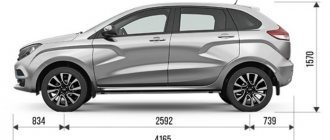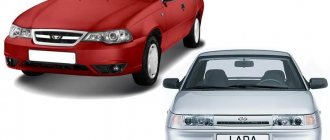The Lada Vesta, which rolled off the production line in 2015, almost immediately became a serious competitor to the leader of the B segment in Russia - the Kia Ria sedan. In order not to lose its “bestseller” status, the Koreans will have to fight with Vesta for their buyer. In this article we will compare the Lada Vesta and Kia Rio to determine who is better.
In just a few years, unsightly Korean brands like Kia and Hyundai have become one of the most purchased cars in the Russian Federation. If earlier people looked at cars of these brands with distrust, today the Koreans have significantly improved the quality of their cars. Of course, KIA and Hyundai do not yet reach the level of German cars, but they can already surpass the Japanese. The Koreans have a high-quality design, good build quality, no problems with parts, and the price is more than competitive. Add here accessibility and good reviews, and the result is a recipe for a good car.
The Lada Vesta went on sale a little damp, but gradually all the shortcomings were eliminated. A year or a little more later, Vesta can already be safely called a competitor to the Korean Rio and Solaris. Every day there are more and more fans of the car. At the plant, the release of the Lada Vesta is considered a small revolution, since practically nothing has changed at AvtoVAZ over the past few decades. And to release Vesta, we had to completely rework the concept of local car production, use new solutions and abandon established principles.
Comparison of the interior of the Lada Vesta and Kia Rio
The Korean car has a more restrained interior. Its color palette is dominated by dark, practical tones. In some variations of Lada you can find bright, saturated inserts of orange, red or beige colors.
Users complain that the buttons in the Vesta are pressed very hard and there is some play in them. Kia does not have such problems. It is praised for its soft seats and high quality plastics inside.
Multimedia systems of competitors are practically no different in functionality and sound. But the car from the Russian automobile industry has a small plus - the presence of a slot for reading data from SD cards.
Car design and exterior
VAZ managed to make a stylish body, which in its appearance is in no way inferior to its closest competitors.
Both sedans have sporty lines. This can be seen in the streamlined shape, the “aggressive” bumper and elongated rectangular headlights. The Kia Rio's radiator grille is narrow and less pronounced. In a Russian car, the emphasis is on it.
Exterior view of the Lada Vesta. Photo source: https://www.drive2.ru/o/b/486028670771659178/
From the rear, the latest version of the Korean car looks in line with modern trends. Its headlights are connected to each other by a thin red stripe, and the muffler is disguised. Some versions of the Lada have a double exhaust pipe that immediately catches your eye. The rear lights are more clumsy and angular.
Among station wagons, it’s also not possible to clearly choose who turned out to be more stylish: Ka Rio X-Line or Lada Vesta SW Cross. Like sedans, these body styles are similar in many ways. The Rio has higher roof rails and chrome door handles, while the Lada has them in body color.
Features of the appearance of competitors
It’s worth starting with the characteristics of the car body, as this is what catches your eye first. At first Vesta only had a sedan. Now the choice has been expanded: there is a station wagon and a cross-version, although the same Kia Rio has a hatchback.
Comparison with Kia Rio
While the coupe version of Vesta, as well as the sports version, are still not production versions, it is worth comparing the Lada Vesta and Kia Rio in terms of sedan body sizes. Let's take a look at the Russian new product and one of the top sellers from Korea.
The length of the Kia Rio is 4380 mm, that of the Vesta is 4410 mm. The Korean car is 1700 mm wide, the Russian car is slightly wider: 1764 mm. Larger than Vesta and 1500 mm in height versus 1470 for Rio.
Comparison of parameters
| At the AvtoVAZ flagship | From a Korean state employee |
| One of the advantages of Vesta is its high ground clearance, it is 17.8 cm, | Only 1600 mm. |
| The luggage compartment volume is also larger: Vesta has 480 liters. | Not much less: 470. |
| Vesta's mass is 1230 kg (fully loaded 1670 kg). | The Korean weighs only 1050 kg, although the load capacity is not much less and amounts to a maximum of 1570 kg. |
| The advantages, albeit slightly, are on the side of the Lada Vesta. This is confirmed by the wheelbase - 2640. | 2570 mm. |
Externally, both models are attractive. And with the release of the next generation KIA Rio, this car has become more solid. In this way, it wins over Lada, since it does not yet have a serious update planned.
Rio and Vesta predominantly use fast-paced and dynamic designs, emphasizing their focus on a younger audience.
The Kia Rio radiator grille, spare parts for Kia cars are made in the corporate style, narrow head optics emphasize the predatory “look”, and fog lights complement the image. Vesta produces the same impression created by standard optics. The radiator grille is massive, with a powerful air intake. X-shaped stampings on the sides emphasize the corporate style. However, the Kia Rio also has its own sides, albeit not as pronounced. “Korean” contains more chromium.
The rear part complements the overall style with massive lanterns and a sloping roof that smoothly merges into the trunk lid. In terms of the attractiveness of the stern, Vesta is in no way inferior to its competitor, so a comparison - Lada Vesta or still KiaRio - is acceptable as a consideration of identical models, alternatives to each other.
Comparison of the “appearance” of Skoda Rapid and Lada Vesta
The Czechs in this regard have always been superior to their direct competitors, and after the acquisition of the company by the German brand Volkswagen, the products began to be of unsurpassed quality, even in budget cars. Skoda cars are not inferior to Volkswagen, but at the same time they are somewhat cheaper than they have earned popularity among many car enthusiasts. When comparing Rapid and Vesta, it should immediately be noted that in terms of the quality of materials, workmanship, etc., the Czech car is superior to AvtoVAZ’s flagship Vesta.
Unlike the predatory and impetuous image of Vesta, the Skoda Rapid has a completely different “appearance”. The German discreet style prevails here, attention is paid to every little detail, and this creates the image of a solid car.
The front of the Rapid is characterized by smooth, classic-shaped optics with large fog lights. The radiator grille is in the form of blinds with wide vertical stripes. Neat doors and wheel arches only confirm the discreet and simple style.
At the rear, square lights are used. There is no smooth transition between the roof and the trunk. All this together creates the image of a classic German sedan. The Rapid does not have a station wagon body, but it has a liftback, which can give Vesta a head start in a station wagon in terms of luggage compartment volume.
As in the previous case, there are no obvious differences in the sizes of these cars; the dimensions of the Rapid are as follows:
- length 4480 mm;
- width 1706 mm;
- height 1470 mm;
- ground clearance 170 mm;
If Vesta wins in size, then in terms of luggage compartment volume the Czech car is ahead (530 liters versus 480). The wheelbase is actually equal: 2630 for the Lada and 2600 for the Rapid.
Comparison with the exterior of the Hyandai Solaris
Recently, the Korean automaker has been striving to rank with the elite brands of Europe. This is how the next generation of Sonata, Elantra appeared, and the new Solaris is catching up to this. In general, the advantage of all foreign budget brands from among Vesta’s competitors is that when updating, engineers do not limit themselves to a light facelift, producing cars of a new generation. Just look at the difference between Hyandai Solaris and Hyandai Acsent, but the latter is the previous generation of Solaris. It is unknown when this will happen with Vesta.
Comparison of Lada Vesta and Hyundai Solaris cannot be carried out in the same way and it is impossible to say unequivocally which one is better. Let's say the dimensions are approximately the same. Here are the sizes of a Korean state employee:
- length 4410 mm;
- height 1494 mm;
- width 1700 mm;
- ground clearance 160 mm;
- luggage compartment 470 liters.
When comparing Vesta with an opponent in appearance, it is necessary to take into account that both models are attractive in their own way. The design option from Korea is being developed taking into account future updates and changes in appearance. The latest generation of Solaris has a sloping body profile and an attractive rear, with sharp and graceful flowing lines used throughout.
Dimensions
Both cars have 4 doors and are designed for 5 seats. The Korean brand has a sedan body length of 4,400 mm, while Vesta is 10 mm longer. “Lada” turned out to be 27 mm higher than its competitor. Its height is 1,497 mm. The difference in width is more significant. For the Rio it is 1,700 mm, and for the Russian car it is 1,760 mm.
Vesta's weight ranges between 1,230 and 1,280 kg, depending on the configuration. The minimum weight of Kia is 1,150 kg, and the maximum is 1,198 kg.
If you compare the Kia Rio and Lada Vesta in size, the Korean car will be easier to drive. The VAZ has an advantage in its stability on the road.
Kia Rio Warranties
Kia is increasing the warranty period for its car to 5 years or 150 thousand kilometers. Some parts are included in the list of those subject to natural wear and tear, and the decision on warranty replacement is made by specialists from Kia service centers. Such parts include filters, chrome design elements, hoses, pipes, windshield wiper blades, brake system parts and many others. Some can be replaced within 1-3 years after the start of operation, others can be repaired on a paid basis. The original battery must be replaced within six months from the date of purchase, after which the warranty period expires.
Luggage racks
For sedans, this parameter cannot be used to determine whether Vesta or Kia Rio is better. The volume of their luggage compartment is identical and amounts to 480 liters.
If we compare the Lada Vesta SV Cross and the Kia Rio X-Line, then the Russian brand has something to brag about. The minimum size of its trunk is 480 liters. The competitor has a lower figure - 390 liters.
The domestic car also wins in terms of space organization. Above the spare wheel niche there are two foam containers with lids. With the rear seats folded down, the floor is flat. On the left side, under the curtain, there is a box for storing small items.
Exterior of the Kia Rio. Photo source: https://yandex.ru/collections/card/5de36b2ac8ba05cdbb215002/
If you fold down the rear seats of the Kia, they form a high threshold. In addition, opening the tailgate is not always convenient due to the small handle.
Doors
On Vesta there is no seal on the door, the seal is only on the body. The Kia Rio has a complete seal along the body and door contour.
On Vesta there is a controversial solution - there is a flap at the bottom, which sometimes covers the drainage holes. There is no seal at the bottom, but there is a good seal along the contour of the door. You won't freeze in winter.
Chassis
The West has an independent front suspension with gas-filled MacPherson shock absorber struts. At the rear there is a transverse beam with levers and coil springs.
In the Rio, the manufacturer also installed a front stabilizer and independent MacPherson struts. The rear suspension is similar - semi-independent with a torsion beam.
According to these parameters, the cars are identical. But in reality, the Lada handles bumps and potholes on the road more confidently. In the Kia, the impacts are felt more strongly. At the same time, at low speeds, the “Korean” corners better due to the stiffer suspension. In such a situation, the VAZ begins to roll more, but the steering wheel of the car is more responsive.
Vesta has more ground clearance - 178 mm, while Rio has 160 mm.
Engine and transmission
All available engine variations are presented in the table.
| Lada Vesta | Kia Rio |
| Petrol, volume 1.6 liters. 106 horsepower. Manual transmission. | Petrol, volume 1.4 liters. 100 horsepower. Manual transmission. |
| Petrol, volume 1.6 liters. 106 horsepower. Robotic gearbox. | Petrol, volume 1.4 liters. 100 horsepower. Automatic transmission. |
| On gas, volume 1.6 liters. 106 horsepower. Manual transmission. | Petrol, volume 1.6 liters. 123 horsepower. Manual transmission. |
| Petrol, volume 1.6 liters. 113 horsepower. Variable speed drive. | Petrol, volume 1.6 liters. 123 horsepower. Automatic transmission. |
| Petrol, volume 1.8 liters. 122 horsepower. Manual transmission. | |
| Petrol, volume 1.8 liters. 122 horsepower. Robotic gearbox. |
Both models are equipped with front-wheel drive only.
Cost of ownership
Maintenance of models deserves special attention. Let's calculate how much routine maintenance at official dealers in Moscow will cost up to a mileage of 60 thousand kilometers (inclusive) for cars with the least powerful engine and manual transmission. Maintenance of Lada Vesta 1.6 (106 hp) 5MT costs: TO-1 (15 thousand km) - 6600 rubles, TO-2 (30 thousand km) - 8800 rubles, TO-3 (45 thousand km) - 6600 rubles, TO-4 (60 thousand km) - 8800 rubles, and Kia Rio 1.4 (100 hp) 6MT: TO-1 (15 thousand km) - 7725 rubles. , TO-2 (30 thousand km) - 9945 rubles, TO-3 (45 thousand km) - 8384 rubles, TO-4 (60 thousand km) - 13316 rubles. The total cost of all Vesta vs Rio maintenance was 30,800 rubles. vs 39,370 rub., i.e. 8,570 rubles (28%) more expensive to service a Korean sedan. As a result, it turns out that for every kilometer driven, Lada pays 51 kopecks for maintenance, and Kia pays 66 kopecks.
The cost of CASCO (theft and damage insurance) is also a very significant expense item when purchasing a new car for those owners who decide to purchase an insurance policy. How much will such risk protection cost? To answer this question, let's compare CASCO prices for cars worth 800,000 rubles for a 30-year-old man with 10 years of experience without children. For example, at Renaissance the CASCO policy will cost 23,796 rubles. for Vesta and 43,460 rub. — for Rio, in the company Rosgosstrakh — 24,826 rubles. and 26,010 rubles, and in the MAX company - 89,100 rubles. and 112,600 rub. respectively. These prices are obtained from online calculators and should not be considered final. However, in their relative terms, it is obvious that insuring a Russian car will be cheaper.
Speed characteristics
In a comparison of the Lada Vesta and the basic Kia Rio, the Russian car accelerates to 100 km/h in 11.3 seconds. Maximum speed – 175 km/h.
Salon "Lada Vesta". Photo source: https://www.zr.ru/cars/vaz/-/vaz-vesta/media/?p=1
The Korean brand showed the worst dynamics in traffic. To accelerate to “hundreds”, it will take 12.2 seconds. But it can travel at a speed of no more than 185 km/h.
In its maximum configuration, the Lada is capable of reaching a speed of 100 km/h in 10.2 seconds. In such an assembly, the speedometer needle cannot be moved beyond the 186 km/h mark.
“Rio” has the best acceleration to hundreds – 10.3 seconds. Maximum speed – 193 km/h.
Interior
But when you look inside the cars, you can see, if not outright plagiarism, then very similar motives in the interior design. It is noticeable that AvtoVAZ designers were impressed by the inner world of the Korean model.
Kia Rio interior.
The dashboard, center console, 3-spoke steering wheel are all pretty similar. Of course, one cannot deny Vesta’s interior originality and originality, but there are certainly similarities. On the other hand, both models are ok with ergonomics, and there are no complaints about visibility either. The finishing materials are of quite high quality, as for class B. But there is definitely more space in the Lada, thanks to the larger dimensions and longer wheelbase. Therefore, in this regard, we can put an equal sign, but with a slight advantage for the Lada Vesta.
But the interior of the Lada Vesta is no worse.
Transmission options
The manufacturer equipped Vesta with three types of gearboxes:
- five-speed manual;
- five-speed robotic;
- variable speed drive.
Rio has less variety:
- six-speed manual;
- six-speed automatic.
The automatic transmission in the Lada causes a lot of criticism. Users complain of extraneous noise under increased loads and acceleration. Experts advise changing the transmission oil or contacting a service center.
The Rio machine has no obvious defects. It has 6 stages, which helps to more successfully select the optimal engine speed.
Bumper height
You can drive up to the curb and not hit anywhere. There remains a gap of less than 1 cm.
Whether I did the right thing by selling Vesta and taking Rio, only time will tell. These will be tests in winter, speed measurements. Let's look at Rio's reliability in terms of penetrability of the suspension, the operation of the electrical part, and how much it can be tuned. Let's try to improve the dynamic parameters. I will also try to tell you about this.
Safety and reliability
Both competitors have Anti-lock Braking System (ABS), Hill Start Assist (HSA), Traction Control (ECS), Stability Control (ESC), and Emergency Brake Alert (ESS).
Salon "Kia Rio". Photo source: https://yandex.ru/collections/card/58a4a7357fd024006cfd81e1/
In the basic kit, Kia only has airbags for the front passenger and driver. Vesta also provides side ones.
In most trim levels, the Lada Vesta, like the Kia Rio, uses drum brakes on the rear wheels. In this regard, the safety of cars is the same.
Lada vesta guarantees
The warranty on the fret 2180 lasts 3 years or 100 thousand kilometers, it is valid subject to compliance with the operating rules and timely completion of technical and complaint inspections. The main components of the car have their own service life. For example, it is recommended to change batteries every 2 years; shock absorbers, bearings, catalytic converters - 1 year or no more than 35,000 km; rubber hoses, silent blocks, drive parts - up to 50 thousand km.
Corrosion, paint defects, malfunctions resulting from improper maintenance or self-repair are not covered by the warranty, as are damage caused during an accident.
Options and prices
Each model has more than 10 configuration options. Therefore, we compare only the basic and maximum assemblies.
West has the cheapest option – Classic. Cost – about 640,000 rubles. It contains:
- immobilizer;
- GLONASS emergency communications;
- electric power steering;
- steel wheels R15;
- fabric upholstery;
- electric window lifts on the front doors;
- heating and electric drive of side mirrors.
The Classic version of Kia Rio costs 795,000 rubles. It contains:
- tire pressure monitoring;
- GLONASS emergency communications;
- electric power steering;
- steel wheels R15;
- air conditioner;
- fabric upholstery;
- hood soundproofing.
The maximum equipment for Lada is Exclusive. The basic version adds:
- remote control lock;
- Cruise control;
- direction indicators on folding side mirrors;
- alloy wheels R16;
- rear parking sensors, camera;
- rain and light sensors;
- spoiler;
- combined upholstery;
- climate control;
- heated all seats and steering wheel;
- fog lights;
- rear power windows.
Price: 950,000 rubles.
The Rio Premium version additionally includes:
- keyless entry;
- rear camera and parking sensors;
- R16 wheels;
- fog lights;
- light sensor;
- heated washer nozzles;
- leather seats, steering wheel, transmission selector;
- climate control;
- heated front window;
- heated all seats;
- navigation system.
Price: 1,105,000 rubles.











